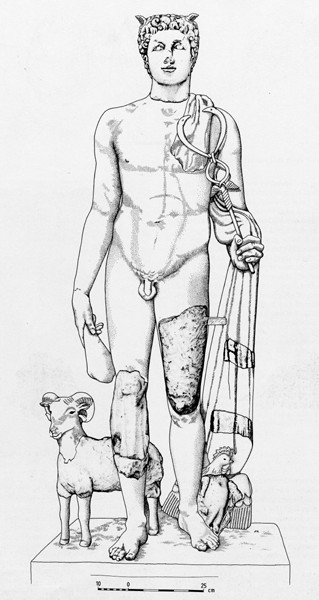
|
| The reconstruction drawing of the cult statue of Mercury distinguishes between the preserved and non-preserved parts of the statue (Woodward and Leach 1993 fig. 76) |
The votive deposits associated with the pre-Roman sanctuary give some clue to the character of the pre-Roman deity. The presence of weapons suggests a martial aspect. In the Roman period the identity of this local god, possibly to be read on an as yet unpublished curse tablet, seems to have been assimilated with the Roman deity Mercury. Mercury is named on curses, stone altars and metal plaques and represented in statues and figurines. The major cult statue probably stood within the cella (see Uley : temple). The god was nude and slightly larger than life-size, accompanied by a ram and cockerel at his feet. The sculptor used local Cotswold stone but the accomplishment of the figure shows a close familiarity with the Greco-Roman tradition of representing the god. Its style dates it to the mid-second century AD, although the surviving fragments were found in deposits of the post Roman period. Better preserved representations of the god suggest that Mercury carried a caduceus (his staff entwined with snakes) in his left hand and a money bag in his right. Among the votive objects were also miniature silver and iron caducei and copper alloy models of the god's cult animals, the cock and goat. The animal bones also show how classical forms influenced the worship of the god (see Uley : cult practice).
Some curse tablets also appealed to Mars and Silvanus as well as to Mercury. Representations of Sol and Bacchus were also discovered at the temple. This may mean that more than one god resided at Uley, or perhaps that these are alternative translations of the local deity into the gods of the Roman pantheon.
The discovery from a fourth century context of a decorated copper alloy sheet, bearing scenes from the New and Old Testaments suggests the possible presence of Christianity among the cults of late Roman Uley. The building constructed over the temple ruins in the fifth century AD has been identified as a church, suggesting the existence of a Christian community at or near Uley (see Uley : history).
previous: other buildings next: cult practice